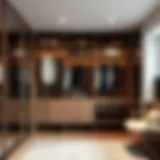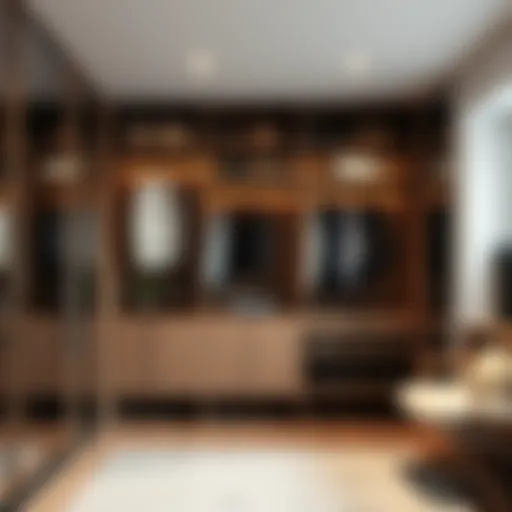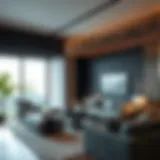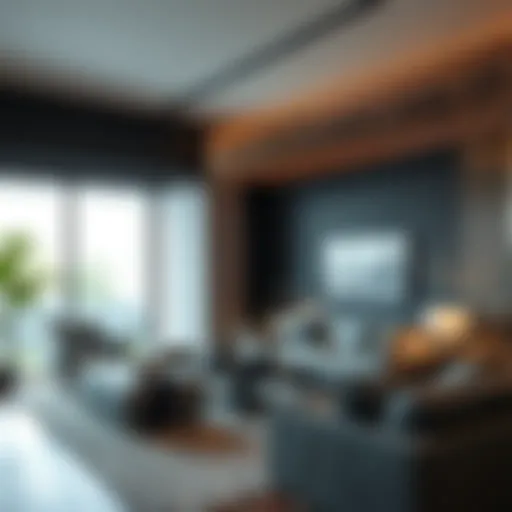Benefits of Cube Bookcases with Bins for Modern Spaces
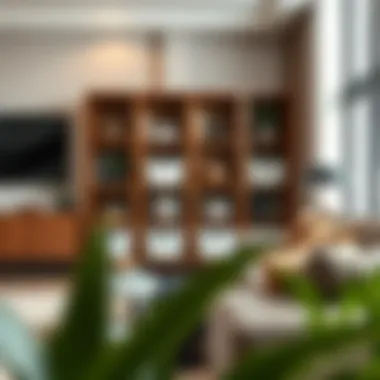
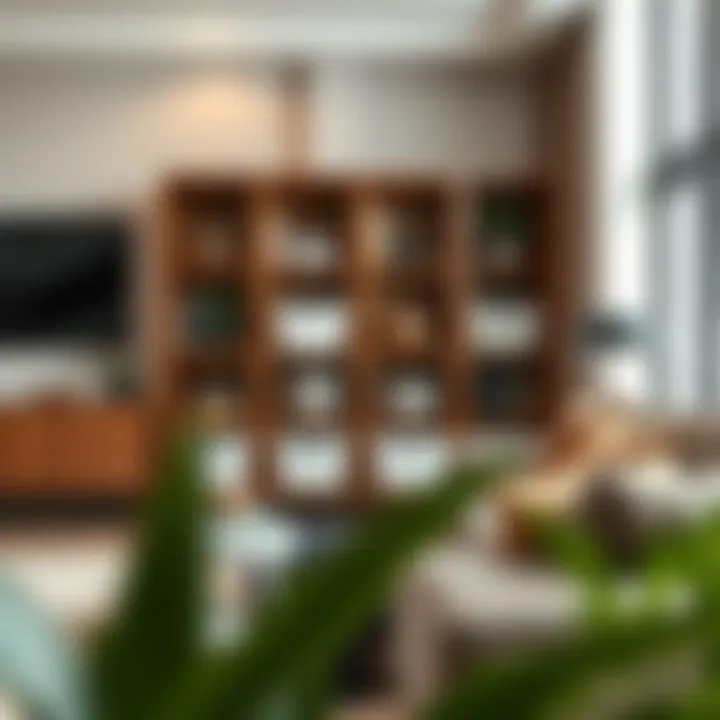
Intro
Cube bookcases with bins have emerged as versatile storage solutions in contemporary design. Their structural composition allows for a blend of functionality and style, fitting seamlessly into both residential and commercial environments. As space becomes a premium in home and office settings, understanding the advantages these bookcases bring can help in making informed choices. This article sheds light on how cube bookcases not only simplify organization but also enhance the aesthetic appeal of any room.
Furniture Trends
In the ever-evolving world of interior design, furniture trends reflect our changing lifestyles and preferences. Cube bookcases, especially those equipped with bins, are currently at the forefront of functional furniture trends. They adapt to various contexts, suiting minimalistic to eclectic designs.
Current Market Trends
The rise in remote work has prompted homeowners to rethink their home offices. Cube bookcases serve as practical solutions, providing the dual function of display and storage. They are now often seen in open-concept living spaces, where they can effectively demarcate areas without the bulk of traditional shelving units. According to a report from Statista, the furniture market is shifting towards modular and multipurpose designs, with cube bookcases leading the charge due to their customizable nature.
Popular Styles and Designs
The design landscape of cube bookcases is not just about their shape; it encompasses various styles that resonate with consumers. For instance, mid-century modern pieces often feature wooden constructions with a smooth finish and simple lines. On the flip side, contemporary designs may lean towards geometric patterns and vibrant colors.
- Open Cubes: Clarity and simplicity define open cube designs, making them perfect for showcasing decorative items.
- Lattice Designs: These bookcases add an artistic flair, creating visual interest through their intricate frameworks.
- Colorful Bins: Incorporating storage bins in different hues enhances the playful aspect and allows for easy organization.
DIY Projects
For those who want an even more personalized touch, DIY projects involving cube bookcases can yield unique results. Engaging in these projects not only fosters creativity but can also save a considerable amount of money.
Step-by-Step Guides
- Choosing a Base: Start with a pre-made cube bookcase from brands like IKEA or create your own from wood.
- Selecting Bins: Find storage bins that complement your home decor. Consider fabric options that can be easily cleaned.
- Personalizing: Paint or varnish the bookcase to match your aesthetic tone; using stencils can create fun patterns.
Budget-Friendly Ideas
- Thrift Store Finds: Often, old bookcases can be repurposed with a new lick of paint and fresh bins.
- Online Tutorials: Websites like YouTube offer countless tutorials to guide beginners through creating customized storage units.
By embracing cube bookcases with bins, homeowners and designers alike can find solutions that marry function with flair. These unique pieces greatly improve organization and can serve as focal points in a room.
"In design, every choice should be a thoughtful one; cube bookcases provide a canvas to express both aesthetic and purpose."
Through this exploration, understanding the vibrant trends and potential DIY applications surrounding cube bookcases will empower individuals to enhance their spaces effectively. For more information on design tips and trends, you can visit Britannica or Wikipedia.
Prolusion to Cube Bookcases
When diving into the world of interior design, cube bookcases should not be overlooked. They sit at the intersection of style and function, serving multiple roles in both residential and commercial spaces. As homeowners and designers look for versatile solutions that do not compromise on aesthetics, cube bookcases with bins stand out as a practical choice.
Definition and Purpose
At their core, cube bookcases offer a modular design made up of individual compartments, often in the shape of square or rectangular boxes. These compartments can be left open or equipped with bins, enhancing the storage options available. The primary purpose of these bookcases is to provide a flexible method for organizing books, decorative items, and everyday essentials while also maximizing space.
Such flexibility appeals to a broad audience. For homeowners, they tackle clutter and offer a stylish way to display personal collections. In office settings, they can contribute to a professional look while ensuring necessary materials remain accessible. The inclusion of bins further amplifies their utility, allowing for easy organization and the ability to hide unsightly items.
Historical Context
The history of bookcases stretches back centuries, but the cube form has gained traction more recently. Initially, bookcases were rigid structures, often heavy and ornate, designed specifically for display rather than storage efficiency. Over time, as homes evolved into multifunctional spaces, the demand for more versatile furnishings grew.
The cube bookcase emerged as a response to contemporary design trends favoring clean lines and open concepts. In the late 20th century, with the rise of minimalist decor and efficient living, this style began to flourish. Major furniture retailers started to embrace this concept, leading to a broad array of designs and colors that fit various themes—from modern elegance to rustic charm. Now, these pieces exist not just as a place to keep books but as a design element with the potential to transform the ambiance of a room.
Design Versatility of Cube Bookcases
Cube bookcases are not just another piece of furniture, they are a canvas for creativity, practicality, and style. When discussing the design versatility of cube bookcases, one must consider the myriad of configurations, styles, and uses these shelves can offer. They adapt well to varied spaces—from cozy apartments to expansive offices—making them an easy choice for myriad design scenarios. Moreover, they provide solutions for storage and display, appealing to a wide audience from working professionals to families needing organization. Therefore, understanding their design versatility is paramount when selecting furnishings for any space.
Styles and Aesthetics
Modern designs
Modern designs are characterized by clean lines, minimal ornamentation, and functional shapes. They stand out in today's interior spaces, captivating those who appreciate a chic, uncluttered aesthetic. A cube bookcase with a modern flair might utilize geometric shapes and a sleek finish, providing not just a storage solution, but an art piece in itself. The absence of clunky designs enhances the overall elegance of a room, drawing attention without overwhelming the decor. However, while modern designs are visually appealing, they sometimes sacrifice practicality, several styles might not be deep enough to hold larger books or items.
Rustic influences
Rustic influences emphasize natural materials and a homely vibe. Cube bookcases designed with rustic elements often feature reclaimed wood or a distressed finish, giving them a charming, lived-in feel. They bring warmth and character, making them a great fit in family rooms and rural homes. The inviting appearance softens a room's atmosphere, transforming the coldness of contemporary styles into something homier. Nonetheless, one must be cautious; rustic designs may sometimes lack structural integrity if not crafted well, so it's crucial to consider quality alongside aesthetics when making a choice.
Minimalist approaches
Minimalist styles make a strong statement through simplicity and functionality. These cube bookcases feature uncomplicated designs and sometimes lack doors, showcasing items on display while keeping visual clutter at bay. Such designs cater especially well to small spaces, ensuring that even with limited room, one can have a stylish storage solution. However, as appealing as it may be to some, minimalism can feel too sparse for others, leading to concerns over the practicality of storage, especially for families or those with diverse items to keep organized.
Color and Material Options
Wood finishes
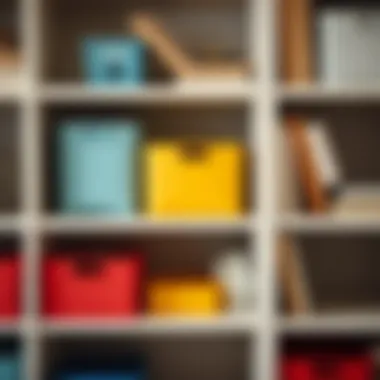
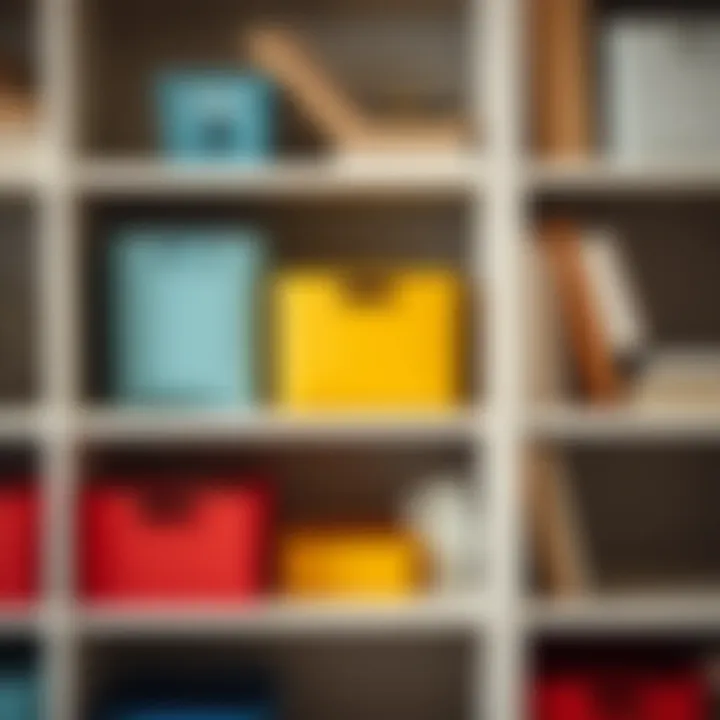
Wood finishes remain a classic choice for cube bookcases, offering warmth and timeless appeal. Different stains and varnishes can dramatically influence the look; from a deep mahogany to a light pine, the range is vast. A wooden bookcase can enhance any interior style. It bridges traditional aesthetics with modern practices, as it pairs harmoniously with various yarns and decor choices. However, wood may require more maintenance, needing polishing to retain its sheen and fight off wear over time, thus calling for consideration of the buyer's lifestyle.
Laminates
Laminates present a practical alternative to solid wood, typically offering a more budget-friendly option. Known for their vibrant colors and patterns, they can mimic nearly any wood or finish while being easier to maintain. Their surface's durability means they can resist scratches and stains, which is great for busy households. Yet, some may argue that while laminates can look good from a distance, they lack the authentic feel and warmth of natural materials. Finding the balance between appearance and action is vital when exploring options.
Metal accents
Metal accents can inject a dash of industrial flair to cube bookcases. Incorporating metal into the design can not only enhance the structural integrity but also add a contemporary aesthetic that's very appealing in modern settings. Often used in conjunction with wood or laminate, metal shelves or frames can make a bold statement and are highly durable. However, it is worth considering that metal can sometimes lack the warmth of other materials, which might not fit every design vision. One's focus must be on achieving a cohesive look that resonates with the overall feel of the space.
The versatility of cube bookcases allows them to serve not just a functional purpose but also as a potent design element in both residential and commercial settings.
Practical Storage Solutions
When it comes to modern interiors, the practical storage solutions provided by cube bookcases with bins are hard to overlook. These units offer not only a stylish display of books and knickknacks but also an organized space that tackles clutter head-on. The functional aspects are as significant as their aesthetic contributions. Let's explore what makes cube bookcases an essential addition to both residential and commercial environments.
Organization and Accessibility
A well-organized space promotes a sense of calm and efficiency—it’s simply a no-brainer. Cube bookcases with built-in bins play a critical role in achieving this order. The very design of these bookcases allows for easy categorization of items. For instance, from children’s toys to office supplies, everything finds a home. Here are a few key benefits of such organization:
- Visual Clarity: Items are neatly stored away, freeing up space from the visual clutter that often plagues our interiors. When all you see is neat boxes or bins, it creates an air of tranquility.
- Ease of Access: With bins that easily slide in and out of their cubes, you aren't rummaging through stacks of books and papers. Needed items are just a quick pull away, making your daily routines smoother.
- Encouragement of Good Habits: Having designated spaces for clutter enhances accountability. It’s much easier to maintain tidiness when everything has a specific spot.
In a living room, these bins might discreetly hide away magazines and remotes, while in a kid’s room, they can become the fortress that confines stuffed animals and building blocks. Awareness of neatness becomes second nature.
Maximizing Vertical Space
In today’s world, where square footage is often akin to gold, utilizing vertical space becomes indispensable. Cube bookcases help in achieving that balance between serving functional needs and optimizing precious real estate.
- Verticality in Design: Cube bookcases often come in various heights and configurations. By stacking units or choosing taller designs, you can make the most out of a smaller footprint, thus providing an illusion of spaciousness.
- Creating Focal Points: Tall, multi-tiered bookcases can turn into a striking focal point in any room. When styled properly, they can transform ordinary vertical space into eye-catching displays that draw admiration while serving multiple purposes.
- Efficient Use of Corners: Corner spaces that often go wasted can easily be leveraged by placing a cube bookcase. This not only creates storage but can also become a creative feature of the room.
By integrating cube bookcases into your space, you’re not simply adding furniture; you’re giving your area the gift of increased functionality and aesthetic appeal, helping your home or office reflect a more organized and thoughtful environment.
"Good organization is as nearly as vital to the discipline of our lives as is a good schedule."
The choice to invest in cube bookcases with bins can be a transformative move for any area, enhancing both form and function. With elements like organization and maximum use of vertical space, it paves the way for a clutter-free and visually appealing setup.
The Role of Bins in Cube Bookcases
Cube bookcases are not just mere shelving units. They represent a blend of aesthetic appeal and functional prowess. The use of bins in these structures enhances their utility and transforms how they fit into our living and work spaces—creating a seamless marriage of style and storage.
Enhancing Functionality
When we talk about functionality, bins play a pivotal role in the dynamics of cube bookcases. They turn an otherwise open shelf into an organized storage haven. Without bins, shelves can quickly evolve into landscapes of clutter, making it easy to lose track of items. Bins offer a solution to that chaos, facilitating a neat and tidy environment.
Consider how bins can help in different scenarios:
- Playrooms: Toys can easily get scattered all over. Bins provide a designated spot for toys, helping children learn organizational skills from a young age.
- Home Offices: Papers, supplies, or equipment can quickly pile up. Bins keep essential items easily accessible but out of sight, lending a clean, professional appearance to your workspace.
- Living Rooms: They can help manage remote controls, magazines, or crafting materials—ensuring everything has its place and can be retrieved without hassle.
The practical benefits are clear and can't be undersold. With various sizes and styles, bins allow for maximizing storage potential without sacrificing aesthetics. They adapt to your needs, whether you want smaller bins for knick-knacks or larger ones for bulkier items. It makes sense; being able to customize your approach to storage means you can create a defined space that suits your preferences.
Aesthetic Considerations
Just because bins are functional doesn’t mean they can't be beautiful too. They can serve as design elements that complement the overall look of the room. Different materials and colors can set the tone of the space, integrating seamlessly into diverse décor styles.
For instance:
- Natural finishes can enhance rustic interiors, serving both as functional storage and as decorative accents.
- Bold colors can inject personality into a minimalist setting, drawing attention and adding a pop of interest.
- Patterns and textures on bins can add visual depth without overwhelming the space.
When positioned thoughtfully on a cube bookcase, bins can create a harmonious balance. They can soften the hard lines of the shelves while maintaining an organized appearance. Having this blend helps in creating not just functional spaces but also visually appealing ones.
Ultimately, bins can transform a basic cube bookcase into a statement piece that celebrates both organization and design. Utilizing bins effectively means you need to think about the overall aesthetic of the room and how the colors and shapes of the bins change the look of the bookcase itself.
"The combination of functionality and aesthetics is what makes cube bookcases with bins not just furniture, but art pieces in their own right."
The role of bins in cube bookcases is integral to achieving a balanced, beautiful, and functional space. They are more than just accessory elements; they serve as essential tools in every setup.
Customization Options
Customization options are key when one considers the integration of cube bookcases with bins into any space. These features enable individuals to adapt the bookcase to their unique needs and style preferences, making the furniture not just a piece of storage but a reflection of personal identity and taste. Engaging in customization opens up possibilities that can enhance both the aesthetics and functionality of a room, resulting in a piece that fits perfectly into one’s environment.
DIY Modifications for Personal Touch
Creativity has no bounds, especially when it comes to personalization. DIY modifications can really bring a cube bookcase to life. Homeowners and DIY enthusiasts alike can take simple cube bookcases and add unique touches that reflect their style. For instance, painting the bookcase in an unconventional color can dramatically change its look. Using chalk paint offers a matte finish, providing a soft texture that blends well in rustic settings.

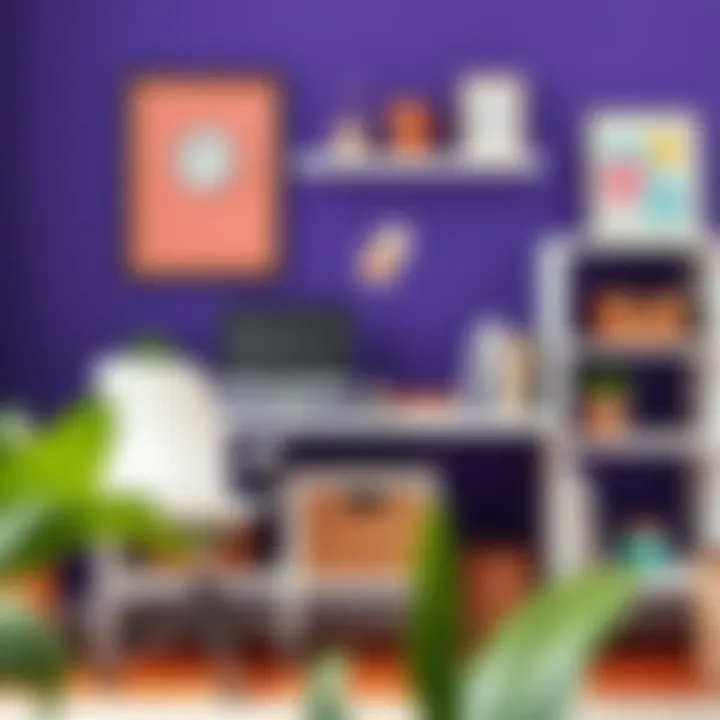
Some may choose to add decorative contact paper within the cubes, transforming standard openings into eye-catching displays. This approach lets every cube tell a story, showcasing the owner’s favorite textures or patterns. To achieve an even more tailored effect, one can incorporate lighting within the bookcase. LED strips placed covertly can provide subtle illumination, allowing books and decorative items to stand out, especially in dimly lit rooms.
Here are a few DIY ideas to consider:
- Add Brackets: For extra stability and a chic industrial look.
- Change Drawer Knobs: Switching out the hardware gives a fresh perspective.
- Construct Additional Shelves: Perfect for those needing more surface area.
These simple modifications can personalize a cube bookcase in a way that mass-produced options might not.
Choosing the Right Size and Configuration
Selecting the right size and configuration is crucial. A cube bookcase that fits seamlessly into a room not only serves its practical purpose but also enhances the overall decor. The first step is to evaluate the available space. Measure the designated area accurately, keeping in mind that a piece that's too large can overwhelm a small room, while a too small bookcase might seem insignificant.
Cube bookcases come in varying sizes and arrangements. Some are designed to stand alone, while others may fit snugly against walls or in corners. The configuration gives further room for thought; some configurations might better suit specific needs, whether it's a horizontal layout for wider walls or vertical designs that draw the eyes upward and give a perception of height. A thought-out arrangement can amplify storage while accentuating elements like wall art or window views.
Consider the following when determining size and configuration:
- Room Functionality: Will it serve primarily for storage or decoration?
- Accessibility: Are the bins and shelves easily reachable?
- Visual Balance: Does the bookcase complement other furnishings?
Finding that perfect fit ensures the bookcase is not just an object, but an active participant in the room's aesthetic and function.
Customization adds a layer of personal ownership that transforms standard furniture into something meaningful and unique.
Ultimately, customization options in cube bookcases with bins extend beyond just aesthetics. They offer homeowners a canvas to express themselves, tailoring their furniture to fit not just their needs but also their ideals, lifestyle and creativity.
Placement Strategies
When it comes to cube bookcases with bins, placement is like the cherry on top of a well-frosted cake. Thoughtful positioning not only enhances functionality but also elevates the visual appeal of a space. A strategic location can turn a simple piece of furniture into a focal point, highlighting its role in the room while promoting optimal use of space.
Living Room Arrangements
In a living room, cube bookcases can perform double duty—serving as both storage and decor. Consider placing a bookcase against a wall that receives natural light; this allows the items inside to gleam and adds warmth to the space. Moreover, back-to-back arrangements with other furniture can create a cozy nook. Incorporating bins in these bookcases helps in hiding clutter, letting enthusiasts show off their reading materials or decorative items beautifully. Think about implementing a mix of open and closed storage options to hit the sweet spot between aesthetics and practicality.
- Opt for color schemes that blend with other furnishings.
- Consider varying heights: a taller bookcase draws the eye upward, making the room feel larger.
- Use the space atop the bookcase to display plants or artwork, melding function with beautification.
Office Environment Considerations
In an office setting, cube bookcases can vastly improve organization and reduce workspace clutter. Positioning them near desks or communal areas ensures easy access to resources like paperwork or books. It’s also wise to consider the flow of movement within the office; a bookcase shouldn't block pathways or create bottlenecks in busy areas.
- Think about how the bookcase fits within the overall office aesthetic. A sleek, modern design may suit a tech startup, while a rustic finish might be perfect for a creative agency.
- Positioning bins by color can also afford a sense of order, making it easy to grab what’s needed without riffling through a jumble.
Children's Rooms and Play Areas
For children’s rooms and play areas, cube bookcases can be a game changer. Place them at a manageable height for little ones, allowing easy access to toys and books. These bookcases become an avenue for teaching organization skills from a young age—make it fun by labeling bins with pictures. This method engages kids, encouraging independence in their tidying up.
- Use vibrant colors or fun shapes to align with the room's theme.
- Consider placing them near reading nooks, creating comfortable spaces where kids can easily reach for their favorite stories.
- Safety matters too, ensure the bookcase is secured to the wall to prevent tipping.
"The placement of cube bookcases in children's spaces can foster not just organization but also creativity and independence in their playtime."
When weaving cube bookcases into any environment, it is essential to thoughtfully consider their placement to ensure they meet both functional and aesthetic needs. The distinctions between living rooms, offices, and kids' play areas can guide us in making informed decisions that harmonize both organization and visual appeal.
Care and Maintenance of Cube Bookcases
Cube bookcases are not only practical for organization but also serve as creative display pieces in various living and working environments. However, just like any other furniture, they require consistent care and maintenance to extend their lifespan and maintain their appearance. Understanding how to keep these bookcases in good shape can enhance their functionality and aesthetic appeal, ensuring they remain a vital part of your space for years to come.
Cleaning and Upkeep Techniques
The upkeep of a cube bookcase revolves around regular cleaning and proper handling. Dust tends to settle more noticeably on flat surfaces, so it's essential to establish a cleaning routine. Begin by dusting the shelves and the exterior using a soft, lint-free cloth or a microfiber duster. This approach enables you to remove dust and debris effectively without scratching the surface. Avoid using harsh cleaners, as they can damage the finish. Instead, a solution of mild soap and water works wonders - just dampen the cloth slightly and wipe down the surfaces.
For deeper cleaning, consider using a wood polish specifically designed for furniture, especially if your bookcase has wooden components; they add shine and protection. Ensure to follow the application instructions, as too much product can leave a sticky residue. It's wise to wipe off spills immediately.
- Tips for Maintenance:
- Use coasters or placemats under items to avoid surface scratches.
- Regularly rotate book and decorative item placements to prevent uneven wear.
- Store heavier items on the bottom shelves to maintain stability.
Dealing with Wear and Tear
Despite your best efforts, wear and tear are sometimes unavoidable. Over time, you may notice scratches, dents, or discoloration on your cube bookcase. Tackling these issues promptly can mitigate further damage.
For minor scratches, a routine trick is to rub a walnut or an almond over the scratch. The natural oils in the nuts can fill in the scratches and blend them better with the wood's color. For deeper scratches, consider using a wood filler that matches the wood grain. Apply it carefully and smooth it out; afterward, finish with a touch of varnish to seal it all in.
If the cube bookcase has laminate surfaces, scratches can be more challenging. A simple trick involves using a matching colored marker to gently color the area.
Additionally, maintaining the joints and fittings of the bookcase is crucial. Periodically check screws or bolts, and tighten them if necessary. With constant handling and changes in temperature and humidity, the integrity of these connections can be compromised.
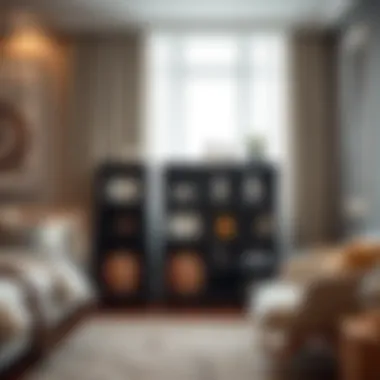
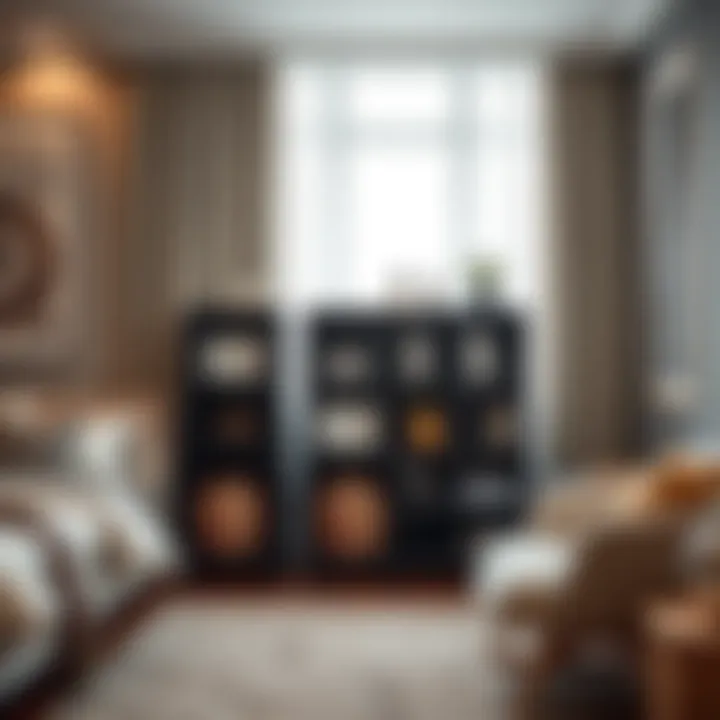
"Taking care of your cube bookcase is not just about appearance; it’s about preserving functionality and ensuring your space remains appealing."
In summary, consistent maintenance and specific attention to cleaning and minor repairs can go a long way in prolonging the life of your cube bookcase. Embracing these practices can help your furniture stay beautiful and functional, reflecting your style and taste.
Cost-Effectiveness and Budgeting
When considering furniture for your home or office, the cost-effectiveness and budgeting aspect plays a crucial role. Cube bookcases with bins are not just about aesthetics; their value proposition rests on how they balance quality, functionality, and affordability. As the saying goes, "You get what you pay for," and this is particularly true in the realm of furniture. Therefore, understanding the dynamics of value versus price in this context is essential for making an informed decision.
Assessing Value vs. Price
The first step in evaluating any potential purchase is to determine whether the quality justifies the price tag. With cube bookcases, value encompasses not only the durability of materials and construction but also how well the piece meets your specific needs. Investing in a higher-priced item can often lead to cost savings down the road, as quality furniture is less prone to wear and tear.
- Material Quality: Look for bookcases made from solid wood or high-quality laminates. These materials not only last longer but also withstand the rigors of everyday use.
- Functionality: A well-designed cube bookcase offers versatility. For instance, whether for displaying books or storing toys, it should function effectively in multiple scenarios.
- Aesthetic Appeal: A stylish piece adds not just function but also charm to your space, enhancing its overall atmosphere.
Often, customers are lured in by lower prices, but compromising on quality can lead to regrettable purchases. In the long run, investing in a robust and visually appealing cube bookcase may save you from repeated costs and dissatisfaction.
Affordable Alternatives
If the budget is tight, there are alternatives to high-end cube bookcases that provide a compromise between quality and price.
- Mid-Range Brands: Many brands offer cube bookcases made from lesser-known materials that still maintain good quality. For example, IKEA’s KALLAX series is renowned for balancing affordability with decent design.
- Second-Hand Options: Checking out platforms like Facebook Marketplace or local thrift stores can yield great finds. Items that might need a little loving care can end up being spectacular additions to your space after some DIY refinishing.
- DIY Projects: Building your own cube bookcase can be a fulfilling endeavor. Plans are readily available online, enabling you to customize sizes and finishes while saving a buck or two.
Sustainability Considerations
Sustainability has increasingly become a buzzword, but in the realm of furniture design, it signifies a deeper commitment to environmental stewardship. Cube bookcases with bins are no exception to this trend. Homeowners and designers alike are looking for ways to incorporate eco-friendly practices when furnishing spaces. As the impact of our choices expands beyond the immediate aesthetic, considering the sustainability of materials and production practices becomes crucial.
To begin, it’s essential to examine the types of materials used in cube bookcases. Eco-friendly materials play a significant role in reducing the carbon footprint associated with furniture production. Materials such as reclaimed wood, bamboo, and recycled composites not only offer distinctive aesthetics, but they also support sustainable practices from sourcing to final product. This approach decreases reliance on virgin resources, lessening deforestation and habitat destruction.
Another noteworthy aspect is the concept of ethical sourcing and production. This entails that the materials used in the creation of cube bookcases are obtained through practices that respect environmental standards and labor rights. Consumers are most concerned about how their purchases can impact the world, prompting a growing demand for transparency from manufacturers. Brands that prioritize fair labor practices and sustainable production will invariably attract a more discerning clientele.
"Investing in sustainable furniture isn’t just a trend; it’s a step towards preserving our planet for future generations."
Incorporating cube bookcases into spaces not only facilitates organization but, when selected with sustainability in mind, also promotes a more responsible approach to consumption. In choosing products certified by organizations like the Forest Stewardship Council or those relying on renewable resources, customers can align their personal values with their home decor choices.
This holistic view empowers homeowners and design enthusiasts to make informed decisions, ultimately contributing to a healthier planet. The interplay between functionality, aesthetics, and sustainability reflects a growing awareness that every choice made in the realm of interior design has far-reaching implications.
Eco-Friendly Materials
When selecting cube bookcases, considering eco-friendly materials can drastically alter their environmental impact. Reclaimed wood, sourced from old structures or pallets, adds character while reducing waste. Bamboo is another excellent alternative, as it grows incredibly fast and replenishes at a rapid rate.
Additionally, composite materials made from recycled plastics and wood fibers provide a sustainable option without compromising on durability or style. These materials can be manufactured to mimic the appearance of traditional wood, allowing homeowners to maintain a classic aesthetic while being environmentally conscientious.
Ethical Sourcing and Production
The ethical sourcing and production of cube bookcases encompasses a commitment to responsible manufacturing. Companies that ensure their materials are sourced from sustainable forests and respect labor rights are paving the way for a more ethical furniture industry.
Ensuring that workers are treated fairly is just as vital as sourcing materials from responsible suppliers. When a brand is transparent about its sourcing and production practices, it not only builds trust with consumers but also sets a benchmark for other companies in the industry. This can enhance brand loyalty as well, as modern buyers are inclined to support businesses that demonstrate integrity in their operations.
Case Studies of Cube Bookcases in Design
When it comes to interior design, the utilization of cube bookcases with bins can be both a functional and an artistic choice. Not only do these furniture pieces provide essential storage, but they also contribute to the overall aesthetic vibe of a space. By examining real-world examples of cube bookcases, we can derive insights into their practicality and versatility across different settings. This section unpacks the specific elements of design, the benefits they bring, and the considerations that make cube bookcases an attractive option for a wide range of environments.
Residential Examples
In residential design, cube bookcases shine in a variety of ways. One notable example is the family living room, where the demands for storage often compete with the need for style. Picture a spacious living area, characterized by modern decor; the inclusion of an open cube bookcase serves as a multifunctional piece that can hold books, display decor, and even conceal clutter with stylish bins.
Consider a case where a homeowner adopts a minimalist approach. A sleek white cube bookcase can blend seamlessly into the environment, providing a sense of openness while still fulfilling storage needs. Alternatively, for a more bohemian touch, natural wood finishes paired with color-coded fabric bins can introduce warmth and vibrancy, creating a welcoming atmosphere.
The design flexibility allows residents to easily reconfigure their spaces. For instance, when a child's playroom transforms into a study as they age, a cube bookcase can morph to meet the new purpose by changing the contents from toys to textbooks. This adaptability is invaluable, making cube bookcases an asset for any evolving home.
Commercial Utilization
Moving to the commercial realm, cube bookcases prove equally beneficial. Retail spaces, for example, may utilize them to create an inviting atmosphere while promoting product organization. A boutique clothing store can use visually appealing cube bookcases to showcase accessories at eye level, allowing customers to experience the merchandise without navigating through clutter.
In office environments, cube bookcases contribute to an organized workspace. Imagine an open-plan office setting where each employee has a dedicated cube bookcase. Here, personal bins for supplies can be juxtaposed with plants and personal items, successfully blending functionality with personalization. The result creates an environment that fosters creativity while promoting a neat workspace.
Furthermore, cube bookcases are a popular choice for co-working spaces, where they can be utilized not just for storage but to define areas, giving the impression of privacy in an otherwise open space. With choices ranging from clear acrylic bins to vibrant colors that enliven the atmosphere, these bookcases can cater to various branding styles.
The adaptability of cube bookcases means they can remain relevant across shifting design paradigms, proving that function does not have to sacrifice form.
In summary, whether in homes or commercial spaces, cube bookcases with bins have a myriad of applications. Their design flexibility allows for significant personalization, making them not just furniture, but integral elements that enhance both functionality and aesthetic appeal.
Epilogue
Cube bookcases with bins have become a staple in modern interior design. They are not just pieces of furniture; they are smart solutions that marry function and form. The article has explored their numerous functional and aesthetic benefits, highlighting how they streamline the organization of both residential and commercial spaces.
Summary of Key Points
- Design Versatility: These bookcases come in various styles including modern, rustic, and minimalist, allowing them to fit seamlessly in any decor.
- Storage Solutions: The inclusion of bins enhances storage capacity and accessibility, making it easy to stow away items while keeping surfaces clutter-free.
- Customization Options: Homeowners can personalize these bookcases through DIY modifications or by choosing specific sizes and configurations that cater to their individual needs.
- Placement Strategies: The versatility of cube bookcases allows for optimal placement in various environments—from cozy living rooms to functional office spaces and vibrant children's play areas.
- Sustainability: Many options made from eco-friendly materials are available, reflecting a growing commitment to responsible sourcing in furniture design.
These aspects make cube bookcases with bins highly relevant in today’s design landscape, serving both utility and style.




